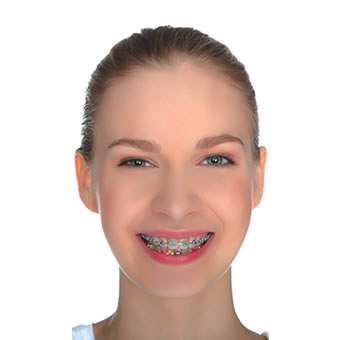Therapeutic Devices
The basic principle of orthodontic treatment is to eliminate the primary cause and proceed with correction of the disorder. If dental and skeletal disorders are caused by finger sucking or mouth breathing, these habits can be prevented using detachable or fixed devices. Eliminating such behaviors in the age of growth stops and even improves dental and skeletal problems.
In general, two types of devices are used :
In general, removable devices are used to correct simple disorders involving several teeth. These devices may have springs for pushing the teeth or screws for expanding the jaw. These devices can usually be used for several months.
Fixed devices, namely brackets, are bonded on the teeth and are often used for more challenging treatments. Brackets are available in metal color as well as in tooth color for use by adult patients. Porcelain brackets are generally used in adult patients. These brackets can display even the least discoloration and therefore oral hygiene and care must be the primary concern.
During the growth era of children, it may sometimes be necessary to get extraoral support in certain cases to correct skeletal disorders. In cases of mandibular progeny, support may be provided using mandibular external elements and in the case of maxillary progeny, collar supports may be used to pull back the upper jaw. Although these devices are generally used for 14-16 hours per day, your orthodontist will determine the duration of use specific to your child.
Patient participation is also very important for an effective and rapid orthodontic treatment. Orthodontics is a teamwork performed collectively by the patient, the orthodontist and the parents of the child. It is very important for patients to wear their detachable devices and intra-oral elasticities as described and in the desired time and to maintain oral hygiene at the highest level.
The Effect of Orthodontic Therapy on Daily Life
Orthodontic treatment is widely used in childhood. The child can do anything during orthodontic treatment, except minor restrictions. He/she can participate in sports activities, sing and play musical instruments. Orthodontic treatment will not adversely affect the success of the child at school and it will improve both the appearance and oral health of the child during development of personality and physical aspects and will provide a more balanced physical and mental health.
The most important consideration during treatment is the correct brushing of the teeth after each meal. Your dentist will help your child how to maintain oral hygiene. The establishment of the habit of tooth brushing during orthodontic treatment is the guarantee of oral and dental health that will last a lifetime.
Prevention of damage to fixed devices is crucial to the effectiveness of treatment. Biting hard foods can damage the wires. In order to prevent this, the patient must be careful in eating fruits with kernels, potato chips, crackers, etc. and avoid frequent consuming of foods that may tack on brackets.
During the initial phase of treatment, the teeth, gums and cheeks may temporarily have various disturbing conditions. This is a natural consequence of the process of getting used to orthodontic devices. This mild discomfort, which can last for 2-3 days, will not be seen during the rest of the treatment.
Duration of Treatment
Simple perplexity, which only concerns the teeth, requires a treatment period ranging from 6 months to 1 year. Although this period differs in each patient, it depends on the type of treatment applied, the type of devices used and the individual factors such as age and sex. In some cases, it may be necessary to extract a tooth in order to correct dental irregularities. In this case, the treatment will usually last 18 to 24 months.
In some skeletal problems that are diagnosed earlier, and which should begin to be treated in childhood, treatment may take longer but the intensity of treatment is reduced. During your treatment, you will need to visit your orthodontist every 4 to 6 weeks on the average. This time may vary depending on your treatment process.




 Orthodontics is a branch of dentistry that deals with the correction of jammed teeth into an ideal line of teeth using removable or fixed devices, as well as with the correction of skeletal disorders through growth orientation. The foundation of orthodontic treatment is based on the movement of the teeth in the bone by applying appropriate forces in the required direction and, if necessary, ensuring the ideal relationship of the soft tissues and bone structures by growth orientation.
Orthodontics is a branch of dentistry that deals with the correction of jammed teeth into an ideal line of teeth using removable or fixed devices, as well as with the correction of skeletal disorders through growth orientation. The foundation of orthodontic treatment is based on the movement of the teeth in the bone by applying appropriate forces in the required direction and, if necessary, ensuring the ideal relationship of the soft tissues and bone structures by growth orientation. Age Factor in Orthodontic Treatment is the first and most important step for an individual to express himself/herself correctly with healthy and regular teeth and a beautiful smile. Perplexed and irregularly aligned teeth do not only cause an aesthetically adverse appearance, but also deteriorate oral and general health.
Age Factor in Orthodontic Treatment is the first and most important step for an individual to express himself/herself correctly with healthy and regular teeth and a beautiful smile. Perplexed and irregularly aligned teeth do not only cause an aesthetically adverse appearance, but also deteriorate oral and general health.